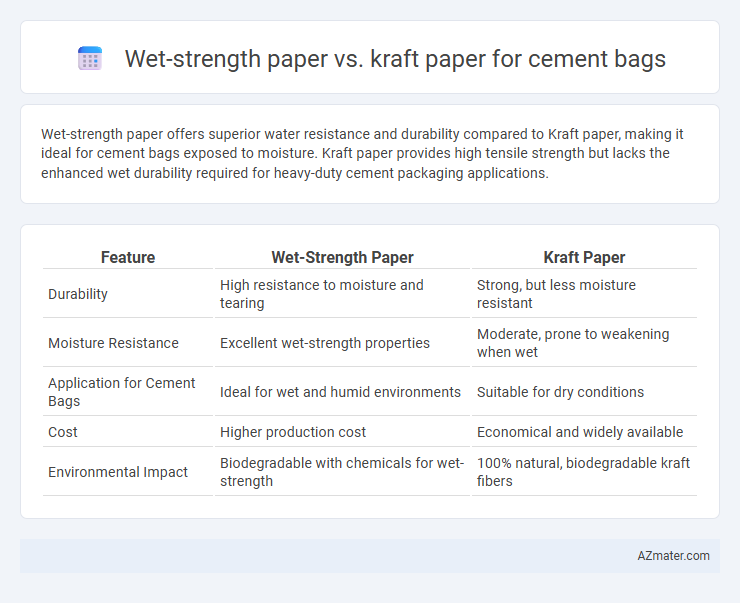Wet-strength paper offers superior water resistance and durability compared to Kraft paper, making it ideal for cement bags exposed to moisture. Kraft paper provides high tensile strength but lacks the enhanced wet durability required for heavy-duty cement packaging applications.
Table of Comparison
| Feature | Wet-Strength Paper | Kraft Paper |
|---|---|---|
| Durability | High resistance to moisture and tearing | Strong, but less moisture resistant |
| Moisture Resistance | Excellent wet-strength properties | Moderate, prone to weakening when wet |
| Application for Cement Bags | Ideal for wet and humid environments | Suitable for dry conditions |
| Cost | Higher production cost | Economical and widely available |
| Environmental Impact | Biodegradable with chemicals for wet-strength | 100% natural, biodegradable kraft fibers |
Introduction to Cement Bag Materials
Wet-strength paper and Kraft paper are essential materials in cement bag manufacturing due to their durability and resistance to moisture. Wet-strength paper is treated to retain strength when exposed to water, making it ideal for protecting cement from humidity and ensuring structural integrity during transportation. Kraft paper, known for its high tensile strength and tear resistance, provides the necessary support and robustness required for heavy-duty cement packaging.
Overview of Wet-Strength Paper
Wet-strength paper is engineered with chemical additives to resist disintegration and maintain integrity when exposed to moisture, making it essential for cement bags subjected to humid or wet environments. It offers high durability and tear resistance, ensuring secure containment of cement during transportation and storage. Compared to kraft paper, which primarily provides strength under dry conditions, wet-strength paper excels in preserving packaging performance under adverse weather conditions.
Overview of Kraft Paper
Kraft paper is a high-strength material produced from chemical pulp through the kraft process, known for its durability and tear resistance, making it ideal for cement bag manufacturing. Its superior wet-strength properties allow it to retain integrity and resist moisture during storage and transportation, ensuring the cement remains secure and uncontaminated. Compared to wet-strength paper, kraft paper offers enhanced tensile strength and chemical resistance, contributing to its widespread use in heavy-duty industrial packaging like cement bags.
Key Performance Requirements for Cement Bags
Wet-strength paper for cement bags offers superior moisture resistance and maintains tensile strength even in humid or wet conditions, essential for preventing bag failure during handling and storage. Kraft paper provides excellent tear resistance and durability due to its long fiber content, but it may require additional coating or treatment to achieve adequate moisture protection. Optimal cement bags often combine wet-strength paper with kraft paper layers to balance strength, durability, and moisture barrier properties, ensuring reliable performance throughout transportation and storage.
Strength and Durability Comparison
Wet-strength paper exhibits superior resistance to moisture and maintains structural integrity when exposed to wet conditions, making it highly suitable for cement bags subjected to humid environments. Kraft paper offers excellent tensile strength and durability in dry conditions but significantly weakens when wet, leading to potential bag failure. Wet-strength paper's enhanced bonding agents improve fiber adhesion, ensuring sustained strength and longevity critical for reliable cement packaging.
Moisture Resistance: Wet-Strength vs Kraft
Wet-strength paper offers superior moisture resistance compared to Kraft paper, making it ideal for cement bags exposed to damp conditions. Its enhanced bonding and resin additives prevent fiber disintegration when wet, ensuring bag integrity during storage and transport. Kraft paper, while strong under dry conditions, tends to lose strength and deteriorate quickly when exposed to moisture, limiting its effectiveness for cement packaging.
Cost and Economic Considerations
Wet-strength paper offers superior durability and moisture resistance for cement bags, reducing product loss and increasing packaging lifespan, though it typically incurs higher material and production costs than Kraft paper. Kraft paper, known for its strength and affordability, provides a cost-effective solution but may require additional treatments or lamination to withstand moisture, potentially raising overall expenses. Evaluating the total cost of ownership, including durability, protection level, and reusability, is critical when choosing between wet-strength and Kraft paper for cement packaging.
Environmental Impact and Sustainability
Wet-strength paper for cement bags offers enhanced durability and resistance to moisture, reducing the need for plastic liners and minimizing environmental pollution. Kraft paper, made from natural wood fibers through a more environmentally friendly pulping process, is biodegradable and recyclable, promoting sustainability in packaging. Choosing wet-strength kraft paper combines durability with recyclability, optimizing environmental performance in cement bag applications.
Industry Standards and Packaging Regulations
Wet-strength paper used in cement bags complies with ASTM D5261 standards for moisture resistance, enhancing durability during transport and storage. Kraft paper meets TAPPI T 240 standards, emphasizing high tensile strength and tear resistance, essential for handling cement's abrasive properties. Industry regulations, such as those from ISO 9001 and FDA packaging guidelines, mandate specific strength and contamination prevention protocols, making wet-strength and kraft paper critical for compliance in cement packaging applications.
Choosing the Best Paper for Cement Bags
Kraft paper is commonly used for cement bags due to its high tensile strength, tear resistance, and durability, providing excellent protection during handling and transportation. Wet-strength paper enhances moisture resistance by utilizing special resins, making it ideal for environments with high humidity or potential water exposure, thus preventing bag disintegration. Selecting the best paper involves balancing Kraft paper's mechanical strength with wet-strength paper's moisture resistance to ensure cement bags withstand both physical stress and environmental factors.

Infographic: Wet-strength paper vs Kraft paper for Cement bag
 azmater.com
azmater.com